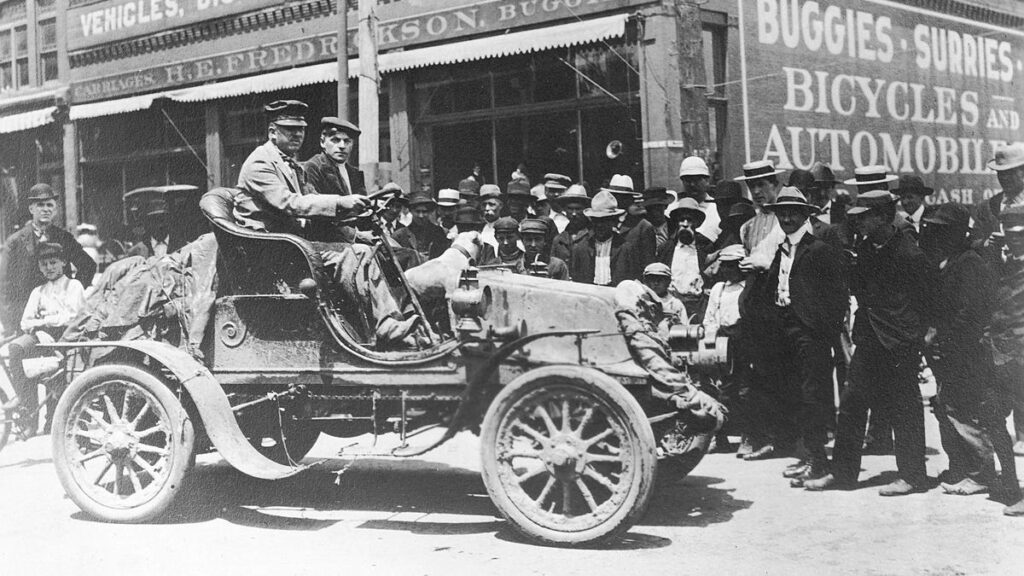The First Cross Country American Road Trip Sucked Up 600 Gallons Of Gas

Some of us have four day weekends to burn here in the U.S. thanks to the 4th of July weekend and a ton of Americans — 43.2 million, as projected by AAA — are planning to hit the road and travel over 50 miles from your home. But were did it all start?
Triumph Is Giving Us The Small Displacement Bikes We’ve All Been Yearning For
The first cross-country road trip would take a little bit longer than a long weekend to complete, but it took only an instant and a $50 bet to spark the idea.
On May 19, 1903 Dr. Horatio Nelson Jackson was hanging out at a private social club in San Francisco as a guest when some of the club members began a debate about cars. Almost no one thought the four (sometimes three)-wheeled personal conveyance was going to catch on. Cars were both unreliable and unsafe, especially on America’s rough, unpaved roads.
Jackson, a native of Vermont, was already something of an adventurer. After contracting tuberculosis forced him to leave his medical practice, Jackson went looking for gold in Alaska and Mexico.
It’s fair to say he was both a rambling man and car enthusiast — though not a mechanic. He was so incensed by the anti-car talk he bet $50 that he could drive from San Francisco to New York in under 90 days. After all, he needed to head to the East Coast anyway.
Now, that may seem like a generous amount of time — the transcontinental railroad, for instance, only took three and a half days to shuttle Americans cross-country — but Jackson and all assembled knew this would be a difficult journey. He’d be driving across deserts, mountains and forests sometimes without any roads at all. There were no road maps, because often there were no roads.
But Jackson wanted that $50. So he hired Sewall K. Crocker to ride along as his mechanic. The pair bought a two-cylinder, 20-horsepower 1903 Winton. When they set off on that fine May 23 day, just four days after the initial bet was placed, things immediately began to prove dicy:
The plan was to avoid the deserts of Nevada and Utah and the higher passes of the Sierra Nevada and the Rockies, so the expedition swung north to follow the Oregon Trail in reverse. They were only 15 miles into the journey when the car blew a tire, and they had to use the only spare they had brought.
North of Sacramento, a woman misdirected them for a total of 108 miles so her family could see their first automobile. When more tires blew out on the rocky road towards Oregon, they wound rope around the wheels. Along the way, they wired the Winton Company for supplies to be sent ahead. Nevertheless, they occasionally had to walk or cycle long distances to find gas, oil, or spare parts.
It didn’t help that two other teams were making the attempt at the same time as Jackson and Crocker — and those teams had the financial backing of automakers interested in being the first to pull off the stunt. When the two picked up a bulldog named Bud in Idaho the press began to take notice. Winton would offer the pair a sponsorship deal, but by that time they were well east of the Mississippi and it was smoother sailing all the way to New York.
In the end, the first road trip across the U.S. would take 63 days, 600 gallons of gas, and cost the independently wealthy Jackson $8,000. The Bureau of Labor Statistics inflation calculator doesn’t go back that far, but in ten years later in 1913 $8,000 was the equivalent of a quarter million dollars.
AlternateHistoryHub has a really entertaining and historically accurate retelling of the trip in fantastic detail:
The Guy Who Drove Across America For A $50 Bet
While Jackson never received his $50 payout, he did become the proud owner of Bud the bulldog and earned himself a lifetime of bragging rights. It really was about the friends he made along the way (and the clout).



